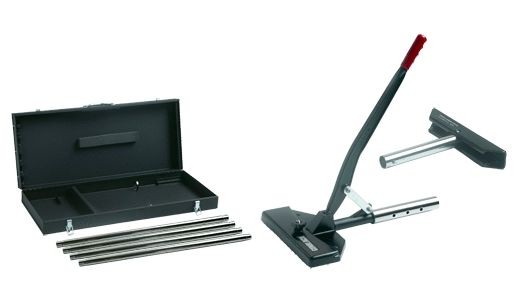Carpet stretching is one of the most frequently requested carpet repairs in Denver. Homeowners call because bubbles and bumps have appeared in their carpet, because seams are separating or/or peaking, or because the carpet appears to be pulling off the tack strip at a transition from carpet to a hard floor. These are irregularities that we are happy to fix. We will address each one of these subject in a series of blogs. This blog will focus on bubbles and wrinkles. Bubbles and Wrinkles Bubbles appearing in your carpeting are a concern; they are a tripping hazard for you and your family and they make a room unsightly. There are two reasons why a carpet will form these bubbles and wrinkles and they are both related to the carpet installation.
- The original installer did not employ his power stretcher or used it very sparingly.
- New carpet was installed on old, compromised tack strip
This is a Power Stretcher, the required tool from proper carpet stretching. Residential carpet is usually made with a synthetic backing that acts like elastic when stretched. The tension of an install stretch is what locks the carpet in place on the tack strip. When the carpet is installed properly, it stays in place without using nails or glue to attach it to the floor. The IICRC, (Institute of Inspection, Cleaning, and Restoration Certification), an internationally recognized authority on standards of carpet inspection, cleaning, and restoration, endorses specific guidelines for proper carpet stretching, not only in Denver, but worldwide. The CRI 104/105 guidelines for carpet installation require the extensive use of a power stretcher, with no skipped space between the areas stretched with the power stretcher. Unfortunately, carpet installation can be done much quicker and more profitably by improperly using a knee kicker instead. Initially, the installation looks good, but the elastic backing will begin to stretch as the carpet is walked on. As this stretching continues, it eventually results in bubbles and wrinkles. Improper carpet stretching is, unfortunately, common in Denver, and many newer homes have issues shortly after they are occupied. Additionally, if tack strip is damaged while removing an old piece of carpet, wrinkles and bubbles can also form. When the old carpet is being removed, a person may simply grab a corner and start to pull it. This pulling creates a rather unique popping sound, almost like a zipper. What is making the noise? The spikes of the tack strip are being bent out of shape as they tear the heavy fabric of the carpet backing. The compromised spikes may hold a new carpet stretch, even a correct stretch from a power stretcher, but not for long. In a short time the backing will pull the carpet off the damaged spikes, creating slack in the carpet backing, which will be visible as bubbles and wrinkles. This problem must be fixed by replacing the compromised tack strip or adding new tack strip, and performing another carpet stretch. To protect yourself and your investment, it is important to hire a properly trained IICRC certified technician. The IICRC certifies technicians for carpet repair and reinstallation, teaching them the guidelines for proper carpet install and stretching. We are happy to provide a quality carpet stretching service for the Denver area. What is involved in corrective carpet stretching? Corrective carpet stretching for a room containing bubbles or wrinkles requires:
- Identifying the cause of the wrinkles, whether improper stretching or compromised tack strip
- Completely clearing the area or room to be stretched
- Setting up the power stretcher:
First, a padded section of wood is placed along the base of one wall that the stretcher foot will brace against. This reinforcement ensures that the force of the stretcher is not concentrated on a small or vulnerable piece of wall that could be damaged. Next, sections of steel tubing are attached to span the room. Finally, the head and handle of the stretcher are attached. The head of the stretcher grips the carpet. As the handle is depressed, the power stretcher acts like a jack, slowing powering the head of the stretcher away from the foot on the opposite wall.
- As each area is stretched into place it is secured to the tack strip. The power stretcher is repositioned the width of the head, then stretched again.
- Proper carpet stretching requires that the carpet be stretched toward each wall, not just one or two. When this technique is completed across both directions of the room, the carpet stretching is complete.
- All that remains is to trim any edges, tuck the carpet under the baseboard, and return your belongings to their place in the room.
Why should I be concerned with how well my carpet is stretched? As mentioned above, the wrinkles and bubbles are unsightly and a trip hazard, but they are also destroying your carpet. Improperly installed carpet wears out from the bottom up, much quicker than carpet that is properly stretched into place. This is because loose carpet moves a great deal more than carpet that is tightly secured. Every time it is walked on, or vacuumed, or furniture is moved across it, the carpet backing rubs against the pad, subfloor, and tack strip. This wearing will eventually break down the carpet backing. By the time the wear is apparent from above, the carpet may require extensive repair or, in extreme cases, complete replacement. Stress and wear of carpet is accelerated when there is excess slack from improper stretching. You will add years of use to your carpet, enhance the appearance of your home, live safer, and save money by hiring a quality carpet stretching company that services the Denver area.

